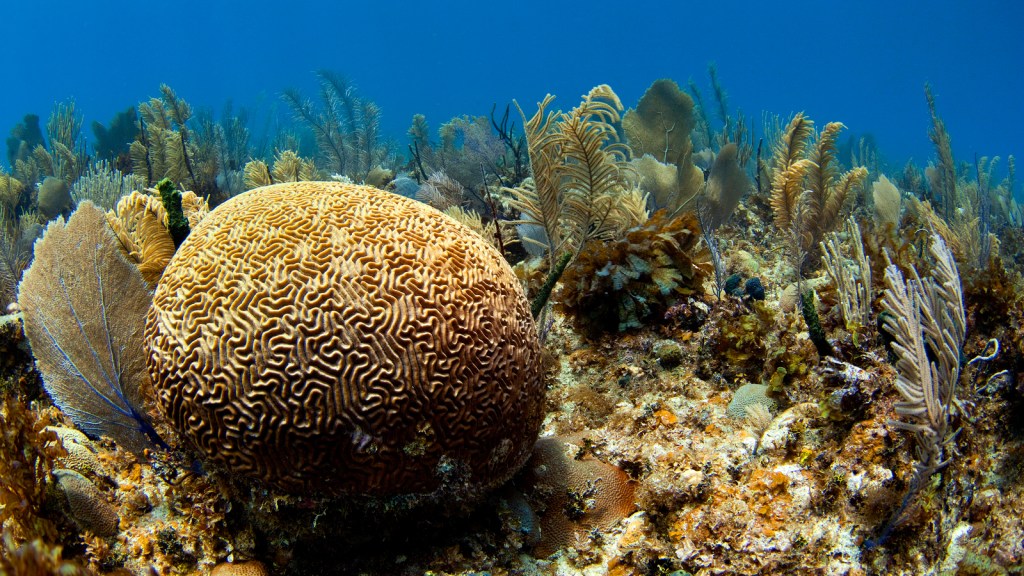It was the kind of surreal conversation about coral reefs, parrotfish, climate change and, well, zombies that could probably only happen in a place like Key West. (Or maybe things like this only happen to me).
It started when a young couple from Michigan sat down next to me in Mallory Square and noticed my field guide to coral reefs. They were going snorkeling, they said, and wondered what they might see. So I showed them pictures of corals and barracuda, and it all went fine—until the parrotfish.
“Parrotfish are my favorite,” I told them. “They eat the algae on the reef and get an occasional bite of coral, and if it’s quiet enough and you’re close enough, you can sometimes hear the crunching sound. Like sitting too close to someone eating chips.”
“Wait.” The woman sounded surprised. “They eat the coral? I thought coral was rock. Like thousands-of-years old rock.”
It is, but the first few millimeters of the reef are alive. And covered with a kind of mucus, but I didn’t say that. Instead, I gave them a short and very simplified version of Coral Reef 101.
Coral Reef 101
It goes something like this: Coral reefs are essentially built by very, very small animals called polyps. They secrete calcium carbonate—limestone—that forms the foundation (or skeleton) of the reef and as long as the polyps are living, the reef will continue to grow outwards and upwards, with generation after generation of living polyps always on the surface.
The coral polyps live by capturing zooplankton and phytoplankton out of the water and by photosynthesis, aided by an algae called “zooxanthellae.” (Zooxanthellae are what give corals their colors). Because corals need a precise combination of water clarity, temperature and depth, they only live in a few specialized places in the world’s oceans. Most corals grow very slowly over thousands of years and any alterations to their environment—such as those caused by pollution and climate change—can have fatal consequences.

Climate change is a particular problem because the heat from rising water temperatures stresses the coral polyps. When they’re stressed, the polyps expel the zooxanthellae, which causes them to bleach, and makes them more susceptible to disease. If the polyps can’t reabsorb the algae pretty quickly, they will die.
That’s why finding ways to mitigate climate change and help coral reefs adapt to warming waters is such an important part of the Conservancy’s work in marine conservation.
Coral Reefs Eat?
I was congratulating myself on my two-minute explanation of coral reef ecology, the challenge of climate change, and (thanks to the Conservancy marine scientists I work with) my ability to accurately pronounce “zooxanthellae,” when I realized the quality of the silence had changed. My new friends were staring at me in a kind of fascinated horror.
“So, you’re saying coral reefs eat? Like, eat eat? Meat?”
I should have just stopped right there, but still—mistakenly as it turned out—thought I could save the conversation.

Well, I said carefully, it’s more like they digest. And though I wouldn’t exactly call zooplankton “meat,” they are animals, microscopic invertebrate animals, sure, but still animals. The corals capture zooplankton as well as phytoplankton (tiny plants) as plankton-rich water moves over the reef. Technically, coral reefs are omnivorous and so yes, I suppose they do, like, eat eat other animals. But only really, really small ones.
Searching for a way to clarify, I—again mistakenly—went with coral-is-living-rock metaphor. It’s an over-simplification, I told them, “but for general purposes, you can think of one part of the reef as living and one part (the calcium carbonate) as dead.”
From Zero to Zombie
They stare at me for a second, and instead of saying something I expect like, “wow, reefs are so cool,” the man said, (and I quote), “Coral reefs are like zombies! Alive and dead, living on flesh.”

Um. Even in my admittedly vast history of odd conversations, I had never gone from zero to zombie quite so fast. And all I could think is that tomorrow, on some dive boat somewhere, these people are going to tell the dive master (and all the other snorkelers) that this writer from The Nature Conservancy told them coral reefs are like zombies.
Calling on the limited knowledge of zombie lore I gleaned from the movie “Shaun of the Dead” and, with great caution and a silent apology to all the marine scientists I work with, I cleared my throat and ventured back into the fray with, “Well, not exactly. For one thing, calling zooplankton ‘flesh’ is a stretch. And also”—I cannot even believe I’m saying this— “zombies are very tough and hard to destroy. Corals, on the other hand, are amazingly fragile. The careless brush of a scuba fin or a hand can kill them and, unlike zombies, they tend to die slowly, silently and without drama.”
They also die without gore, which, my tourists pointed out, may be unfortunate.
“That’s too bad,” the woman said. “Because that bleaching sounds really scary. If corals bled and made noise, and, you know, were above water—maybe more people would know about the scary things that are happening to them.”
Which is, you know, true. And as we all turned to watch the famous Mallory Square sunset, it occurred to me that my Michigan tourists were right about something else as well. What’s happening to coral reefs all over the world is more frightening and, unfortunately, more real than any zombie movie ever made.




Good read. Thanks. I hope that your work will help the Great Barrier Reef.